Source: Outlier Ventures; Compiled by: Songxue, Golden Finance
What is token ownership?
Many early Web3 companies started with a big idea and aimed to revolutionize the decentralized technology world. Even the best innovations require some form of funding to get off the ground and build the intended flywheel economy. These self-enforcing ecosystems are often built with fungible cryptographic tokens that can be used for user adoption, behavioral incentives, and the product itself. Therefore, raising funds not only on equity operations but also on future tokens is a common strategy, especially if overall market sentiment picks up again.
Token vesting refers to the supply of tokens released to the market within a certain period of time. Token vesting refers to the release of allocated token supply to early investors and contributors. Since they play a crucial role in the building phase of Web3 startups, they receive discounts or even “free” token allocations, meaning they have a lower entry point as later investors and market participants. Applying a supply release schedule to the allocations of these privileged entities will align their long-term benefits to Web3 startups while being more equitable to later entrants.
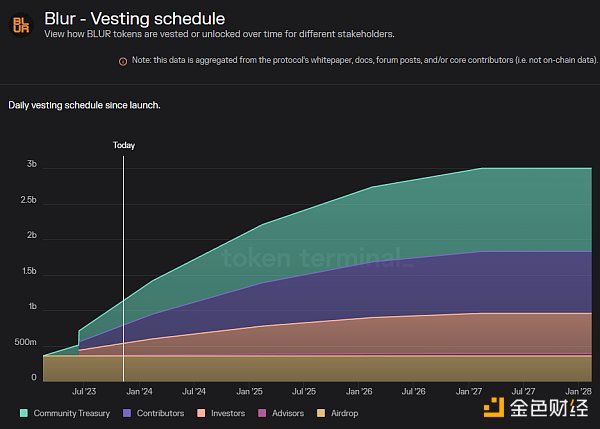
Figure 1: Obfuscating token ownership via token terminal
Figure 1 shows the $BLUR token Exemplary vesting schedule. In addition to airdrops, most of the supply will be released within 4 years after an initial 6-month cliff. These numbers are fairly common in the latest market narratives. During the 2021 bull cycle, we view vesting periods of 12 to 18 months as the standard range. This brings us to the actual topic of this article, which is how to choose and master the right vesting terms for our early investors and contributors.
Short-term or long-term vesting?
The previous section identified the range of possible vesting schedules we see in the market. These scopes are largely narrative driven and derived from what others have done in the current market situation, but are not based on what is best for the overall Web3 initiative. When designing a redemption schedule, you should definitely consider what is the best narrative, but you should also keep other factors in mind, such as:
Early Investors and Contributors
Recognizing early investors and contributors in the vesting plan recognizes and rewards the risk taken by stakeholders who have supported the project from its inception. These individuals and entities often provide the necessary capital and resources for the initial development and growth of the project. They are interested in receiving liquid tokens as quickly as possible, but also in the long-term health of the startups they invest in.
Fair
Market participants will consider exercise conditions when conducting due diligence on Web3 projects. If They claim vesting terms are unfair and could lead to bad sentiment about the project and hinder future adoption. Equity refers to the fair distribution of benefits among all stakeholders. Fairness ensures that no party is disproportionately advantaged or disadvantaged as a result of the vesting provision. This is to create a level playing field where long-term players are rewarded for their commitment, while still allowing new entrants to participate and benefit. In most cases, this means that the lower an investor's entry point into valuation, the longer their vesting period.
MaintainInvestability
< p>Token valuation tables and corresponding vesting schedule design play an important role in future investability and are in tension with launch requirements for rapid financing. Creating a sale at a lower valuation compared to the expected public offering valuation, coupled with a shorter vesting period, may attract more funding in the early stages but reduce investability in future rounds as later investments Investors believe they are at a disadvantage relative to the original investors.
Ecosystem sustainability and stability
The redemption schedule should be designed with the project ecology in mind the need for sustainable development of the system. This involves establishing a schedule to avoid flooding the market with tokens and causing value dilution, thereby maintaining stability. A well-thought-out vesting schedule prevents wild price swings and ensures that token issuance matches the project’s stage of growth and development, thereby supporting the ecosystem. A more advanced approach to maintaining sustainability and stability is to adopt an adjusted attribution approach.
Timing and Intervals
Timing considerations relate to the specific time intervals between token releases to stakeholders . It is important to align these releases with strategic milestones and the overall progress of the project. Proper timing helps maintain momentum, signal project maturity, and manage market supply. By timing vesting based on the project roadmap and development stage, participants can rest assured that vesting is part of a strategic plan and not part of a short-term incentive plan. Keep in mind that the actual release of tokens should not be temporary but gradual. When a large amount of supply hits the market at once, it can cause significant volatility. A better approach is to release smoothly over time to reduce market manipulation and volatility.
Community Vesting
Community incentives are also typically awarded for a specific time period. Some recent vesting schedule designs include individual address-based assignments to market contributors. It is critical to leverage these community incentives as effectively as possible. This means that every dollar issued in the form of tokens should help accumulate more than one dollar of value for the protocol. In many cases, this is achieved by incentivizing core ecosystem behavior and product adoption.
These aspects are not comprehensive and there are many different angles that need to be carefully weighed and considered when it comes to token release in the economy. A basic angle is to create the right demand to offset the token release. Imbalances between supply and demand can lead to volatility and disruption in the token ecosystem. Strong Web3 startups will pay attention to these dynamics and try to predict different scenarios.
Simulating vesting schedules – case studies
The following case studies show vesting schedules of varying lengths Impact on token valuation. It was implemented using the Outlier Ventures open source quantified token model radCAD under standard settings and medium adoption assumptions. Figure 2 shows the general structure of QTM, which has evolved since the first publication on the initial spreadsheet QTM.
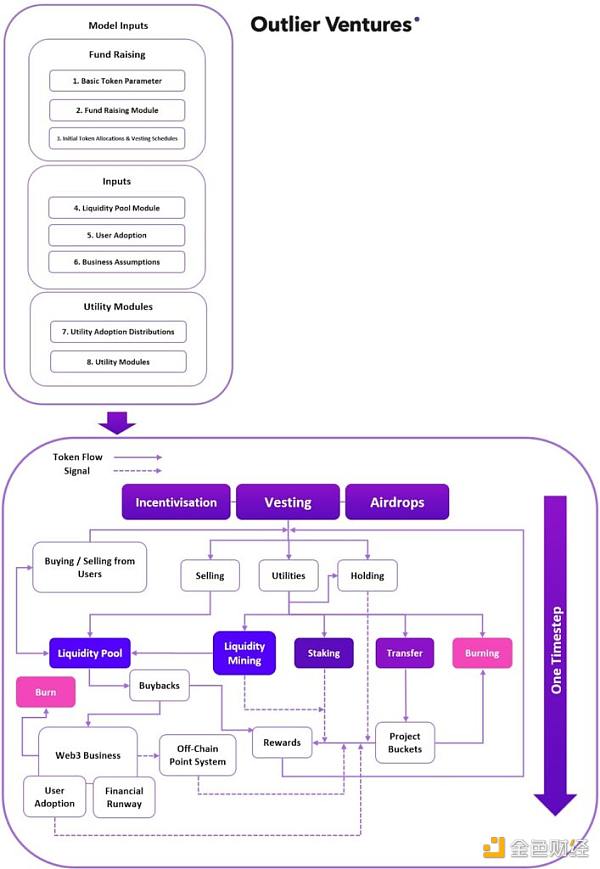
Figure 2: Quantitative Token Model Abstract
Please remember that no model can predict any token valuations, and they should not be constructed as financial advice, especially static and simplified models. However, with QTM we can assume that given a certain adoption scenario, and then apply different redemption schedules to test what would happen if they changed. In the study below, the exact same conditions are applied in the model, except for vesting periods of different lengths, to understand their impact on token valuation stability.
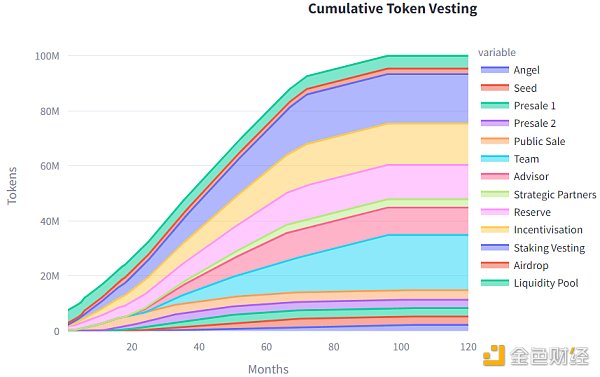
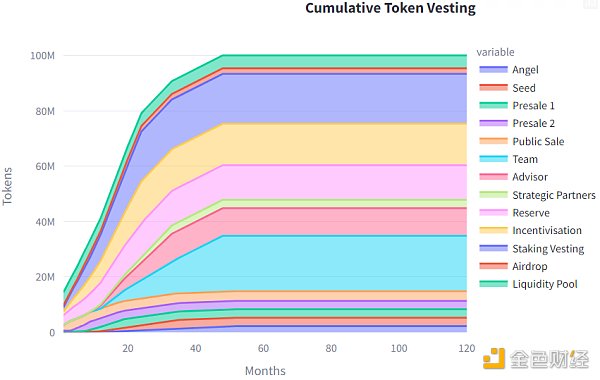
Figure 3: Slow (top) and fast (bottom) vesting schedules for the Quantified Token Model (QTM) case study
Figure 3 shows two Assumption fulfillment timetable for each test scenario. The image above depicts slow vesting and the image below depicts fast vesting. As can be seen, there are many different stakeholders involved, such as different funding stages, early investor groups, teams, advisors, partners, reserves, incentive and staking vesting buckets, airdrops, and liquidity pools. These ecosystem players are common to a variety of different protocols. In this case study, no product or token utility is specified other than general staking and transfer utility that can represent a variety of different mechanisms such as store purchases or ecosystem fees. The exact use case is not relevant to this study.
It will take 8 years in the case of slow vesting and 4 years in the case of fast vesting to fully release all tokens into the economy. This includes the time period from the token issuance, including the cliff phase, where the majority of investors will fully vest early.
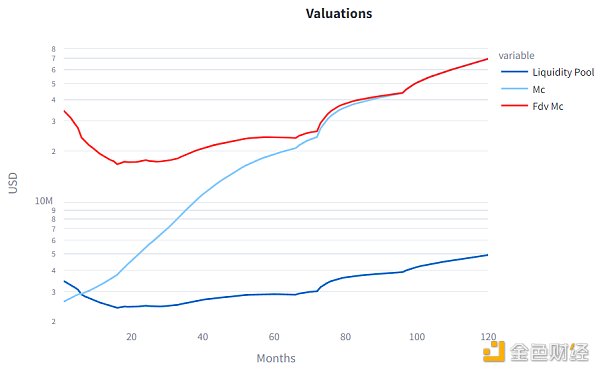
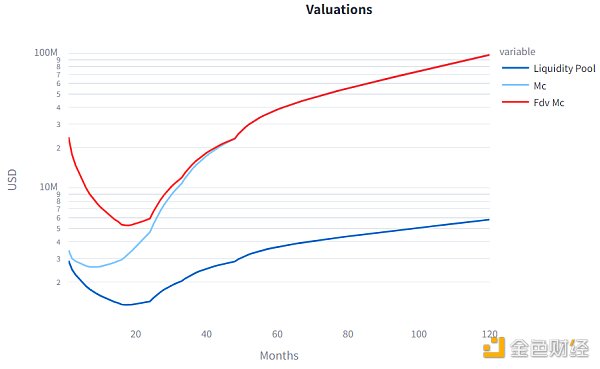
Figure 4: Token valuation resulting from slow (top) and fast (bottom) vesting plans
Figure 4 shows the two types given in Figure 3 Token and liquidity pool valuations derived from QTM simulations under different vesting plans. It is worth noting that the vertical axis is shown on a logarithmic scale. In both cases, the fully diluted valuation (FDV) market capitalization (MC) at launch is $40 million. Both cases show a similar curve shape, where the FDV MC decreases at the beginning of the simulation and starts to increase after some time. MC in circulation only decreased in the fast vesting scenario but also started to increase after 8 months. A decline in valuation over the first 2 to 3 years can be observed in many Web3 token issuances and is caused by the large amount of token supply released into the market while the startup is still in the building phase. Subsequently, assuming the business model, token design, and GTM approach are successful, valuations may rise again due to increased demand.
An interesting aspect is the range of valuations in both cases. Compared to the launch valuation, the FDV MC for the slow cash-out scenario drops by approximately 58% 16 months after launch and peaks at +74% at the end of the 10-year simulation. In the fast-vesting scenario, FDV MC valuations decline by approximately 87% after 18 months, but peak at +145% at the end of the simulation. Although QTM cannot predict these results in an absolute manner, it can provide insight into the impact of initial parameter changes given the same boundary conditions and underlying assumptions. In this case, it is worth noting that slower vesting results in a valuation that is less different from the launch valuation and therefore less volatile than the fast vesting case. Slower redemptions result in smaller valuation declines, but at the cost of potentially less long-term upside potential.
Here we need to discuss two questions: (1) What is the root cause of this observation? (2) What does this mean for our own redemption design?
The reason for the larger valuation decline in the quick cash out scenario is that more token supply is issued to the economy in a shorter period of time. When more supply meets the same demand, it leads to a more severe decline in valuations. At the same time, releasing more supply into the economy faster will lead to smaller releases later on. In both cases, it is assumed that the Web3 business and token demand side continue to grow healthily as well. Therefore, compared to a slower vesting scenario, fewer tokens are issued later to satisfy the same demand, resulting in higher later valuations.
Considering the previous reasoning, we can conclude that a faster vesting schedule is better for long-term token valuation. This is true in the given situation, but there are actually more factors to consider, such as community sentiment. A large token devaluation is rarely associated with good market perception and therefore may even lead to long-term damage to the protocol's image and ultimately a decrease in adoption. Although the protocol cannot control market conditions and the actual demand for tokens, there are some factors that can be controlled, such as vesting design.
Conclusion
The above discussion and case studies show that there is no perfect static vesting plan that takes into account all influencing factors, such as early investor and contributor interests, market participants Interest, fairness, investability, sustainability, token stability and appropriate incentives. Every redemption schedule is a compromise.
Macroeconomic QTM simulation shows the difference in token valuation and volatility between slow and fast vesting plans. We acknowledge that this is not an accurate prediction of the future due to the static and deterministic nature of the model, but it supports the expectation that slower vesting tends to result in less volatility compared to faster vesting. While the simulation shows higher long-term token valuations in a fast-vesting scenario, it does not account for the potential reputational damage to the protocol once early market investors and token holders lose significant amounts of dollar-denominated value.
Another aspect of vesting plan design that cannot be underestimated is the complexity and complexity of vesting plan implementation. In the author’s opinion, the most beneficial vesting occurs when it aligns with actual demand and protocol adoption, as it benefits all participants – even early investors. However, this advanced approach requires careful engineering and clean on-chain execution, which may not be achievable for all early-stage, especially smaller, Web3 startups.
If the protocol does not have the ability to adopt more advanced methods, some good practices can still be applied to traditional static vesting plans to be more conducive to the design of the token economy:
The exercise schedule is designed as a corresponding part of the protocol growth roadmap;
Without any utility and basic demand, tokens will not be released to the market;
Web3 businesses go through three stages: building, scaling and saturation. Most tokens should be issued during the scaling phase rather than the building phase. Matching cliffs and redemption periods accordingly is key.
Vesting through cliffs and longer term deferrals needs to be fully explained to early investors. Ultimately, they will benefit from less aggressive redemption plans as they provide breathing room for better product adoption and thus more counterparties for their profit realization.
There is no perfect delivery timetable, and more engineering resources should be allocated to advanced designs only if the Web3 business is capable. Therefore, it is important to find the right compromise between the above aspects.
 JinseFinance
JinseFinance
 JinseFinance
JinseFinance JinseFinance
JinseFinance JinseFinance
JinseFinance JinseFinance
JinseFinance Joy
Joy JinseFinance
JinseFinance Catherine
Catherine JinseFinance
JinseFinance TheBlock
TheBlock